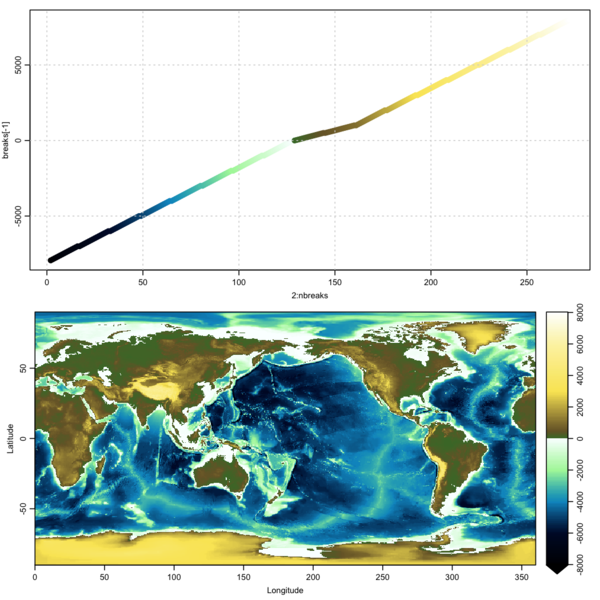GMT topography colours (II)
Jan 30, 2014
The GMT colour palette is illustrated with ocean topography.
This follows an item about GMT colours. In the meantime I have found a website illustrating the colours, and also the definition files for those palettes.
The palette in question is named GMT_relief, and it is defined in a file that is as follows.
# $Id: GMT_relief.cpt,v 1.1 2001/09/23 23:11:20 pwessel Exp $
#
# Colortable for whole earth relief used in Wessel topomaps
# Designed by P. Wessel and F. Martinez, SOEST
# COLOR_MODEL = RGB
-8000 0 0 0 -7000 0 5 25
-7000 0 5 25 -6000 0 10 50
-6000 0 10 50 -5000 0 80 125
-5000 0 80 125 -4000 0 150 200
-4000 0 150 200 -3000 86 197 184
-3000 86 197 184 -2000 172 245 168
-2000 172 245 168 -1000 211 250 211
-1000 211 250 211 0 250 255 255
0 70 120 50 500 120 100 50
500 120 100 50 1000 146 126 60
1000 146 126 60 2000 198 178 80
2000 198 178 80 3000 250 230 100
3000 250 230 100 4000 250 234 126
4000 250 234 126 5000 252 238 152
5000 252 238 152 6000 252 243 177
6000 252 243 177 7000 253 249 216
7000 253 249 216 8000 255 255 255
F 255 255 255
B 0 0 0
N 255 255 255R code to read this file and construct 16-piece linear ramps between the levels is as follows.
1
2
3
4
5
6
7
8
9
10
11
12
13
14
15
16
17
18
19
20
21
22
23
breakPerLevel <- 16 # say
d <- read.table("GMT_relief.cpt", comment="#", nrows=17,
col.names=c("l", "lr", "lg", "lb",
"u", "ur", "ug", "ub"))
nlevel <- length(d$l)
plot(c(1, breakPerLevel), c(1, nlevel))
breaks <- NULL
col <- NULL
for (l in 1:nlevel) {
lowerColor <- rgb(d$lr[l]/255, d$lg[l]/255, d$lb[l]/255)
upperColor <- rgb(d$ur[l]/255, d$ug[l]/255, d$ub[l]/255)
breaks <- c(breaks, seq(d$l[l], d$u[l], length.out=breakPerLevel))
col <- c(col, colorRampPalette(c(lowerColor, upperColor))(breakPerLevel))
}
## drop a colour to get length matchup for imagep()
col <- col[-1]
nbreaks <- length(breaks)
par(mar=c(3,3,1,1), mgp=c(2,0.7,0), mfrow=c(2,1))
plot(2:nbreaks, breaks[-1], col=col, pch=20, cex=2)
grid()
library(oce)
data(topoWorld)
imagep(topoWorld, breaks=breaks, col=col)
A graph of the results is below.
